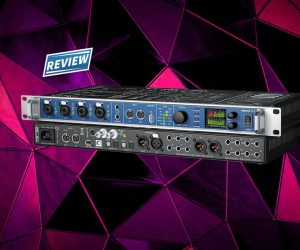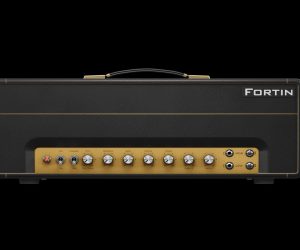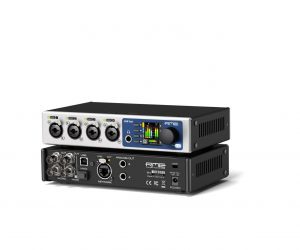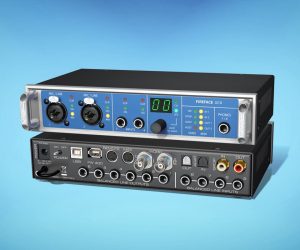
Review: RME Fireface UFX II & UFX+
RME’s two new flagship interfaces make you draw the line between want and need.
In the last 18 months, RME launched not one but two ‘flagship’ single rack unit audio interfaces — Fireface UFX+ and Fireface UFX II. The UFX+ was a 20th anniversary celebratory release which added the features of the MADIface USB to Fireface UFX, taking its I/O count to an impressive 94 channels at 48k (54 at 96k). The sheer number of I/O enabled by the addition of MADI necessitated both USB 3 and Thunderbolt protocols on the UFX+. With analogue I/O, AES, MADI, ADAT, USB 3 and Thunderbolt, it seemed like the most future proof interface one could buy.
Hot on its heels, the Fireface UFX II followed within six months with a much smaller I/O count of 30 channels. While it shares an identical front panel with the UFX+, the UFX II is quite simply a second generation UFX, with updated conversion, preamps, headphone amps and onboard direct-to-USB recording features (DURec). All features that were refreshed for the UFX+
NEEDS/WANTS
When I heard about the UFX II, I was shocked. I’ve been thinking about updating my existing RME system for a while and I couldn’t work out why anyone would want anything other than the UFX+. The truth is, however, I wasn’t placed to instantly enjoy the benefits of the more elaborate system. I don’t own any MADI converters, don’t presently have a Thunderbolt-enabled machine, and have absolutely no requirement for such a high channel count. My obsession was almost entirely driven by gear lust, coupled with a belief that USB 3 and Thunderbolt must be the only future-proof options.
As it happens, greed costs. The MADI optocouplers are impossible to implement for a bargain. Subsequently, the privilege of celebrating RME’s birthday will cost you an additional $900 over the UFX II; with current street prices widening the gap even further. What’s a gear slut to do? Surely what everyone else says is true; a Thunderbolt interface promises far lower latency than ever before. RME has always retorted, ‘Tosh!’ but here’s my chance to pit my needs and wants in a battle to the death. With the help of Park Orchards Recording’s Evan Lorden, we assembled a selection of five Windows 10 and Mac OS X (from 10.9 through to 10.12) systems, and locked ourselves in for several days of testing between RME’s two top interfaces.
PORTS AIN’T PORTS
First, a community service announcement: Read your manual! You’ll find this all-important sentence in the UFX+’s spiral-bound hard copy. “It is not possible to guarantee reliable and highest performance of USB 3 operation with any computer and cable just because they claim to support USB 3. The real performance has to be evaluated on a per USB 3 port (!) and per cable basis.” Truer words have never been written.
Almost every issue I experienced in testing came down to the use of dodgy USB 3 cables — one from OfficeWorks, and one 5m cable purchased online. Both were junk and resulted in anything from severe audio instability to complete inactivity and system instability, including USB mouse dropouts. Once we used only the provided 1.8m cable (a longer one would’ve been nice) everything became clear. Thankfully, RME’s USB drivers provide a real-time error diagnostic and the manual has helpful tips on debugging your system. The bottom line is: one error equals an unstable system.
NEED TO KNOW
RME Fireface UFX II & UFX+
Audio Interfaces

DEFINITELY, MAYBE
I can say one thing with reasonable certainty as far as RME devices are concerned. The type of interface connection you choose should have no impact on roundtrip latency (the delay you experience between a performance and hearing it back via software). Your OS, however, can make a difference. Talking about Mac systems only, we pulled interesting results related to the OS X version installed. On a current spec, up-to-date machine, USB and Thunderbolt results matched, while a mid-2012 iMac running OS X 10.9 returned USB results 0.5ms slower. It could be the chipset or the interaction of chipset and OS. It’s not clear. Neither is it a disaster; it simply highlights the host of factors influencing audio performance.
When it came to benchmarking multichannel audio stability under CPU-load, things became less clear. On the newer of the two Windows 10 systems (a 2017 Dell Inspiron i7 Desktop – hardly an audio powerhouse) USB 2.0 outperformed USB 3 somewhat, while in the case of my ageing i7 quad-core studio workhorse (which features USB 3 ports highlighted by RME as inconsistent) results were unexpectedly reversed. The Mac results were equally jumbled. On the 2012 iMac, both the UFX II (USB 2.0) and UFX+ (USB 3) matched the UFX+ (Thunderbolt) results; while a 2015 15-inch MacBook Pro had the Thunderbolt slightly in arrears.
I’m not trying to make any sweeping statements here but these results suggest there are no guarantees USB 3 and Thunderbolt will automatically assure faster performance. The people at RME know what they speak of when they say it can be a port by port affair. On an optimised system, it may be possible to achieve increased stability under load with both USB 3.0 and Thunderbolt, but this is highly dependent on a number of things. As more and more devices (4K displays, hard drives, etc) seek to get on board the Thunderbolt train, it may be easier to find an empty space on your good old USB bus. What it made clear to me is that, at least for now, your present audio requirements should overrule all clumsy attempts at techno prophecy. With either of the UFXs in your arsenal, you should feel well-armed for the foreseeable future.
HIGHLIGHTS PACKAGE
RME’s decision to implement both USB 2.0 and 3.0 modes within the UFX+ makes a significant difference to the number of systems with which near-optimal performance can be achieved. While using USB 2.0 does sacrifice the additional MADI channel count, there was not a single system or port that we failed to utilise successfully. When the going got tough, USB 2.0 got going.
I was already impressed with the preamps on the Fireface 802, but the additional preamp gain is welcome and I’m increasingly confident in the ability of built-in preamps to cover many of those uncoloured, workhorse roles. Likewise, the two, new high powered, low impedance (2Ω) headphone amps performed beautifully, exposing the detailed width and depth of the converters when tested with Audio-Technica ATH-M70x and AKG K271 headphones. One note of warning: the ‘Factory’ Setup of TotalMix FX sets these outputs to -20. Based on my time reviewing freshly completed masters, -40 would be a safer starting point. Dedicated control is close to hand on the far right of the front panel, nevertheless it’s worth defining your own custom setup.
TotalMix FX is not new but remains one of, if not the most flexible mixing and routing environments provided within an interface. As with RME’s driver performance, TotalMix offers benchmark low-latency monitoring with roundtrip figures of 34 samples (0.7ms at 48k and 0.35ms at 96k). TotalMix allows you to reconfigure inputs and outputs for standalone or AD/DA converter operation — digital inputs routed to analogue outputs and vice versa — generate as many monitor mixes as you have hardware outputs, or submix multiple inputs, or software outputs, within or between applications without any need for external loopback cabling. Its EQ and Dynamics can also be printed or used only for monitoring purposes.
The DURec function creates up to 60-channel recordings directly to a connected USB storage device like a thumb or hard drive, essentially turning the UFX into a multichannel master recorder you can carry with you. You can configure it from within TotalMix or via the front panel screen — the latter isn’t difficult, just fiddly. Improved in this current implementation is solidified performance and support for a wider range of devices. I had no problems enabling a selection of inputs and sub-group outputs for recording while disconnected from any computer.
PICKING NITS
I make no secret of the fact that I’m a long-time RME supporter. Nevertheless, in most happy relationships there are still some sticking points. While RME has never stopped doing what it does very well, it’s been slow to capitalise on existing opportunities to add value to their devices — something that competitors are now doing at similar prices. One simple example is specific to the UFX+. As discussed earlier, the manual details potential issues associated with poorly spec’d USB 3 cables and yet the 1.8m cable supplied will, in many cases, fall short of the length required, and the replacements you purchase yourself are no guarantee to pass the test. A 3m cable would follow through on RME’s attention to detail in a way that makes a genuine difference to users.
More universally, the number of slots available for custom user TotalMix Setups has remained at six for some time, just as the mixer has only ever offered a single FX bus (shared by Reverb and Delay effects, in series). The official mobile app for TotalMix FX is also still available only as a paid iOS offering. There is no shortage of third-party solutions for this, with TotalMix templates to boot; still, it’s a reflection of a fixed set of priorities that doesn’t always compare favourably with competitors (e.g. Presonus’ QMix-UC app, discussed in the StudioLine mixers review in this issue). If you choose RME, you do so for high performance and long-term support, it’s just that the occasional stocking stuffer would be a nice bonus.



























It should be noted that RME have released fully functioning betas of their new iOS control software and it is stunning. Totalmix FX can be controlled from an iPad, or another Mac, from any networked location, either local or WAN. Pretty impressive stuff.
Also, you mention only 6 custom setups. That may apply to Layout Presets, but there are in fact 8 Sanpshots or setups available at any one time.
Regards,
Matt
Essentially, the ufx ii is a + without madi, the 802 is a ufxii with the ufx1 mic-pres (noisier )and (mildly inferior) headphone amps and less “bells and whisles”, but if you look carefully, the core spec is the same
eg aux input s/n ratio, freq response etc